Menus
- What you must remember
- Themore
- Theless
- Prices
- Make yourSuzuki RM-Z 250 2018
- Opinion
- Replaces
- The technical aspect
- Competitors
- Gallery
- Related articles
The 250 RM-Z does not evolve for 2018 – In order to maintain its level of performance, the Suzuki confirms its confidence in its 2016 evolution, while maintaining the good general balance resulting from the previous model. 2017 brought only a few cosmetic touches, wearing black on the rims, triple tree and decorative points. Let’s see how this model was able to motivate itself previously:
Engineers’ objectives for the 2016/18 model:
/ Improved performance directly from the factory racing machines:
– Suzuki Holeshot Assist Control (S-HAC) improved.
– KYB PSF2 Fork.
/ Engine performance:
– A wider rev range for the arrival of power.
– Engine brake reduction.
– Improved start-up.
– Increased durability and reliability.
/ Driving performance:
– Increased cornering performance.
– Maneuverability preserved.
– Overall weight reduction.
– Improved sense of absorption
Suzuki Holeshot Assist Control (S-HAC)
Suzuki Holeshot Assist Control (S-HAC) is an assisted starting system selectable from the handlebars and directly from the factory machines. The S-HAC facilitates the departure of the pilots from the grid to favor the holeshot. Introduced in 2014 on the RM-Z 450, this system is now standard on the RM-Z 250, more sophisticated, more efficient.
Features of Suzuki Holeshot Assist Control (S-HAC):
1. Changed ignition mapping for a quick start. (only during system operation)
2. Selectable in 2 modes depending on field conditions.
3. Control of the 3 stages of starting for a more precise launch.
Since 2016, S-HAC has been analyzing the 3 stages of start-up because Japanese engineers have broken down the start-up sequence into 3 phases.
The times of the start, the crossing of the starting grid, and the acceleration, are all different; which requires different engine characteristics for a better start. Which leads to different settings for each phase.
– The S-HAC is selectable in 2 modes so that the pilot adapts to the starting conditions.
– Mode A: for hard surfaces or slippery conditions on the starting grid. In operation, the Holeshot Assist Control intervenes on the ignition time during the departure phase and when crossing the gate to reduce wheel slip and provide a moderate launch. Then it advances the ignition in the acceleration phase to increase its speed. 3 conditions can reset the ignition in normal mode: a time of 6 seconds after the start; the passage of the 4th gear; or the closing of the accelerator (the most frequent case).
– Mode B: for conditions on the starting grid offering good grip and requiring an aggressive launch. Under these conditions, the S-HAC advances the ignition time to allow increased throttle response and greater acceleration on the straight. But the level of ignition progress is optimized for each of the 3 phases. The system returns to normal ignition under the same conditions as mode A.
– The system can be deactivated when departure assistance is not required.
– Mode selection: the S-HAC button must be held down for more than 0.7 seconds, until the indicator light flashes slowly. Then release the button to engage mode A.
– To choose mode B: hold the button for more than 1.8 seconds until the indicator light flashes rapidly. Then release the button to engage mode B.
Improved engine performance
To increase engine performance, more than 80 internal parts have been redesigned for the 2016/2018 model. 10 main axes guided this work:
1. Piston, piston pin and rings
– The piston now benefits from a shot-blasted surface treatment for greater durability. The shape and material of the piston have not changed.
– Piston pin is coated with DLC (Diamond Like Carbon) surface treatment to reduce friction and improve durability.
– The segments now use an L-section. Sealing is improved and gas leaks are reduced.
– These changes help to increase durability as well as the power range..
2. Reduction of crankshaft inertia and increase of rotor inertia
– The weight of the crankshaft is reduced (the diameter is reduced by 0.5mm) to reduce friction related to oil vapors.
– Rotor weight is increased to compensate for reduced crankshaft weight.
3. Camshafts and intake valves
– Intake and exhaust camshafts are modified for a greater range of engine performance.
– Intake valves are redesigned to increase compression ratio and increase intake efficiency. Compression ratio increased from 13.5: 1 to 13.75: 1.
– These changes help to increase the power range and smooth out the arrival of power..
4. New decompression system
5. New kicker gear, idler gear and breather gear
6. New timing chain tensioner
7. New housings
8. The opening angle of the throttle is increased from 0.6 degree to 1.1 degree.
9. New clutch cover, with the addition of an oil level window for easier maintenance.
10. AMA sound regulation (only US specifications)
– The internal parts of the silencer are changed to conform to the
AMA sound check.
– The manifold is extended by 40mm to increase power at low and mid revs.
With these engine changes, power and torque at mid-range are optimized while maintaining maximum power. The power delivery is smoother and more linear for easy control.
Objective of the chassis
1. Increase performance.
2. Maintain maneuverability.
3. Reduce weight.
4. Improve the feeling of absorption.
– The steering column is redesigned. (same length as RM-Z 450)
– The interior of the pivot beams has a ribbed structure.
– The lower frame connection is redesigned.
– The weight of the chassis is reduced by 2.5% compared to the old model.
– All of these changes optimize chassis stiffness while reducing weight, which contributes to better cornering performance..
The RM-Z 250 is fitted with the PSF2, the latest version of the KYB air fork.
Benefits of the PSF2 system
– Settings:
With a spring, the pilot may need to change it for a softer or harder one depending on his weight or level. With the new PSF2 fork, the rider no longer has to buy additional springs. The pilot can change the preload with an air pump to find the right setting. In addition to the preload adjustment, the rebound is now adjustable in two ways, slow and fast.
– Light weight
The spring – the heaviest part of the fork’s damping – is eliminated. The PSF2 is 1 kg lighter than the old SFF.
– Increased damping performance.
Thanks to a springless design, the barrel body is enlarged, allowing better damping and performance stability over time.
– Low friction
Without a spring, friction is reduced. Lubrication is constant.
The KYB shock absorber incorporates an adjustment system to facilitate access to settings. Slow and fast rebound and compression are adjustable on the shock absorber cylinder. In accordance with the change of suspension, the shape of the strut of the suspension link has been changed for a better feeling.
Front brake caliper redesigned for weight reduction; this new caliper is 10% lighter than the previous one.
Dunlop tires
– The original tires, Dunlop MX51, were replaced by MX52.
– The MX52 series has been designed with CTCS (Carcass Tension Control System) technology which optimizes the stiffness of the tire..
– For the rear tire, softer compounds were used for the sidewalls in order to achieve a better feeling of absorption..
The Renthal Fatbar aluminum handlebars. It is more solid and helps to dampen vibrations.
Excel aluminum rims have been specially designed to be resistant to all uses, whether in Supercross, Motocross and off-road in general..
Two plugs are provided to allow fine-tuning of the injection settings according to the field conditions. One enriches while the other impoverishes the injection compared to the standard plug. The “richer” will be more suited to muddy and sandy soils, while the so-called “poor” will suit small, rather hard and dry soils. You will be able to modify the motor character of your machine to best meet the driving conditions, by simple connection..
What you must remember
Themore
Theless
Prices
8 299 €
Price
nine
Compare
the credits
Make
yourSuzuki RM-Z 250 2018
Estimate, calculate and compare the cost of insuring your motorcycle.
Calculate the cost of
insurance
Test the price of the motorcycle insurance specialist
Opinion
on 3 opinion
users
Read the reviews
Replaces
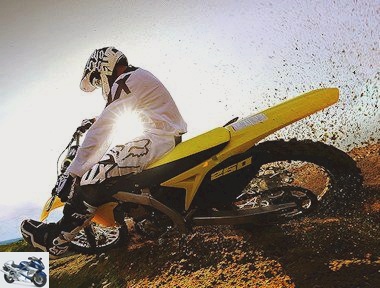
RM-Z 250 2017
Model marketed in
2013
2014
2015
2016
2017
2018
2019
The technical aspect
Suzuki RM-Z 250 2018
- Frame
- Frame: perimeter aluminum
- Tank: 6.5 liters
- Seat height: 955 mm
- Length: 2170 mm
- Width: 830 mm
- Height: 1270 mm
- Wheelbase: 1475 mm
- Weight in running order: 106 kg
- Train before
- Ø 48 mm inverted tele-hydraulic fork
- 1 disc Ø nc, 2 piston caliper
- Front wheel:
80/100
– 21
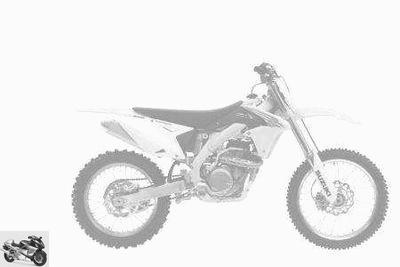
- Transmission
- 5-speed gearbox
- secondary by chain
- Rear axle
- Mono-shock absorber
- 1 disc Ø nc, 1 piston caliper
- Rear wheel:
110/90
– 19
- Motor
- Single cylinder
in line
, 4 stroke - Cooling: by water
- Injection Ø nc
- 2 ACT
- 4 valves
-
249 cc
(77 x 53.6 mm) -
≈ 38
ch - Compression: 13.75: 1
- Crit’air:
Detached pieces
exhaust
motor
fluid
electricity
filtration
braking
chain kit
Competitors
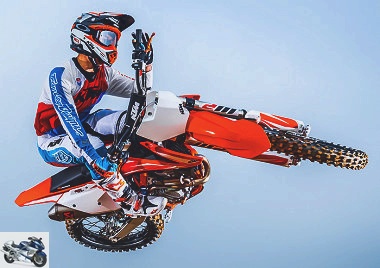
2018 KTM 250 SX-F

Kawasaki KX 250 F 2018

2018 Honda CRF 250 R
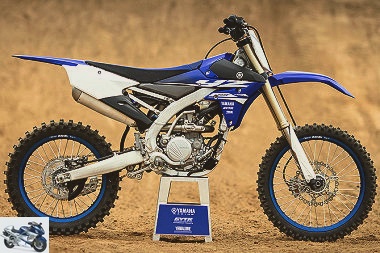
Yamaha YZ 250 F 2018
Gallery
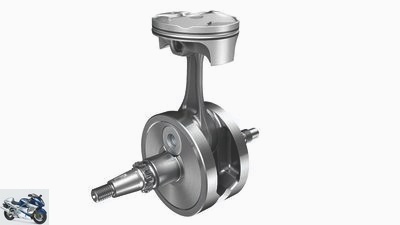

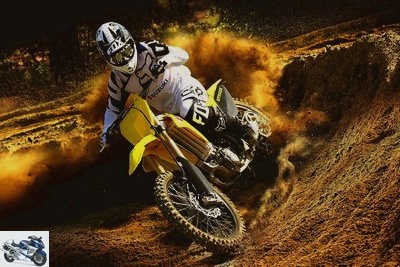

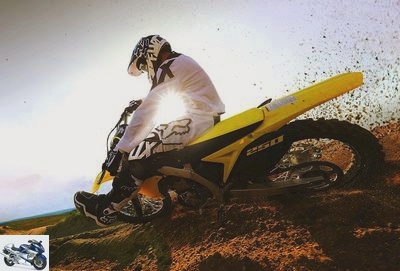
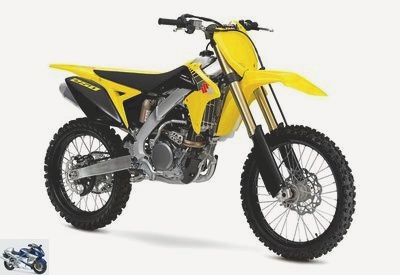
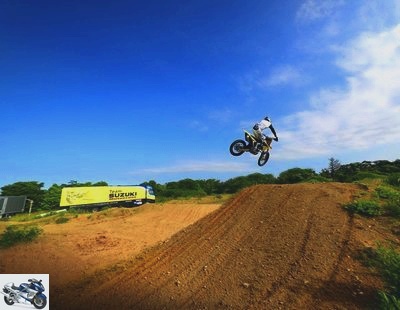
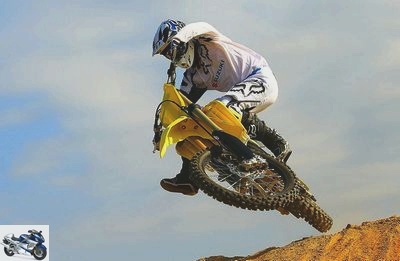
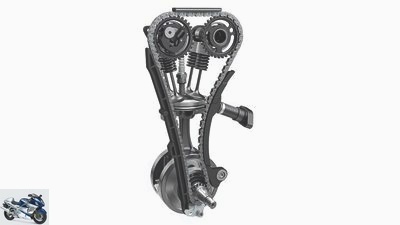

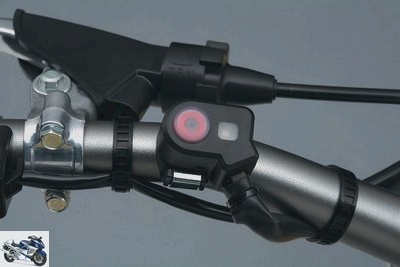
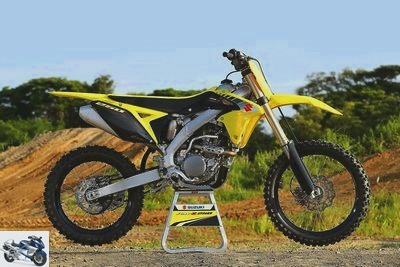
Related articles
-
In order to maintain a high level of performance, the Suzuki RM-Z 250 builds on its 2016 evolution, while maintaining the good general balance resulting…
-
In order to obtain the highest level of performance, the Suzuki RM-Z 250 further evolves for 2016, while maintaining the good general balance resulting…
-
Apart from a few decorative elements and touches of black on the rims, triple tree and number plates, the Suzuki 450 RM-Z does not evolve in 2017. It…
-
The RM-Z 450 is directly inspired by the “factory bikes”, recently ridden by Clement Desalle, Kevin Strijbos and James Stewart in the Motocross World…
-
The big RM-Z never did things by halves, nor wanted to compromise. Basically, a motocross must do three vital things: move forward, turn and stop – and…
-
The big RM-Z never did things by halves, nor wanted to compromise. Basically, a motocross must do three vital things: move forward, turn and stop – and…
-
The new 2015 RM-Z 450 is directly inspired by the “factory bikes” currently ridden by Clement Desalle, Kevin Strijbos and James Stewart in the Motocross…
-
After the 450 last year, it is the turn of the 250 RM-Z to receive a big evolution. In developing this new cross-country machine, Suzuki once again…
-
The Suzuki RM-Z 250 receives an optimized chassis and powerful suspensions, including the Showa SFF fork whose damping functions are separated in the…
-
No big changes in 2014 for the Suzuki RM-Z 250 but all the same some evolutions – Enough to wait until the 2015 model which should move quite a bit….